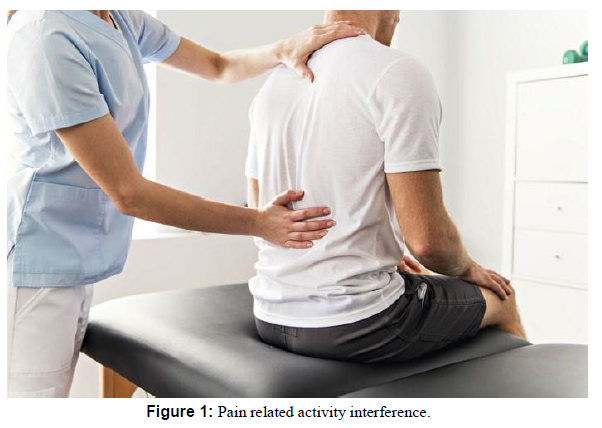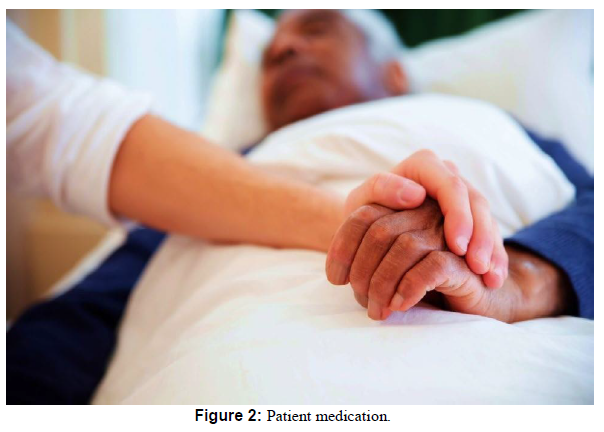Patients Reports of Medication Side Effects and Pain-Intensity
Received: 18-Apr-2023 / Manuscript No. JPAR-23-99997 / Editor assigned: 21-Apr-2023 / PreQC No. JPAR-23-99997 / Reviewed: 05-May-2023 / QC No. JPAR-23-99997 / Revised: 10-May-2023 / Manuscript No. JPAR-23-99997 / Published Date: 17-May-2023 DOI: 10.4172/2167-0846.1000507 QI No. / JPAR-23-99997
Abstract
The purpose was to examine the unique association between reports of medication side effects and pain-related activity interference in a sample of patients with chronic pain. It was also of interest to examine the potential role of patients’ gender, pain intensity, and negative affect as moderators of the association between self-reports of medication side effects and pain-related activity interference.
Keywords: Chronic pain; Psychological determinants; Changes in pain; Treatment of medication; Patients activity; Potential response
Keywords
Chronic pain; Psychological determinants; Changes in pain; Treatment of medication; Patients activity; Potential response
Introduction
In our study, we examined the unique association between reports of medication side effects and pain-related activity interference by controlling for a number of pain-relevant variables that have previously been found to be associated with activity interference in patients with chronic pain. For example, in line with many previous studies, we found that month-to-month increases in pain intensity were associated with higher ratings of pain-related activity interference [1]. We also found that increases in negative affect were associated with higher ratings of pain-related activity interference, which is consistent with the findings of previous studies that have examined the psychological determinants of pain-related disability. The main finding that emerged from our study is that increases in perceived medication side effects were associated with higher ratings of pain-related activity interference even after controlling for month-to-month changes in patients’ levels of pain and negative affect. This unique association between perceived medication side effects and pain-related activity interference suggests that medication side effects have the potential to interfere with activities independent of patients’ pain and affective states [2].
Methodology
We found that pain intensity, negative affect, and perceived medication side effects all emerged as having significant unique influences on pain-related activity interference, suggesting that these variables might represent addictive risk factors for poor functional outcomes in patients with chronic pain. The results of a subsequent analysis indicated that the unique association between reports of medication side effects and pain-related activity interference could not be attributable to differences across patients in any baseline or pre-existing characteristics [3]. While it was important to control for month-to-month changes in pain and negative affect when examining of side effects and pain-related activity interference might possibly have been influenced by some unobserved variables, but results indicated that these variables could not entirely account for the association that was found between side effects and pain-related activity interference. In the present study, we were also interested in examining some of the variables that might moderate the association between reports of medication side effects and pain-related activity interference. Consistent with previous studies, we found that women experienced significantly greater medication side effects than men; however, the magnitude of the association between reports of side effects and pain- related activity interference did not differ significantly as a function of patient gender [7]. Moreover, neither pain intensity nor negative affect moderated the association between reports of side effects and pain-related activity interference. The latter results suggest that the association between medication side effects and pain-related activity interference was not particularly more pronounced when pain or negative affect increased from month to month [8]. The findings of the Figure 1: Pain related activity interference. the association between perceived side effects and pain-related activity interference, a wide range of pre-existing variables could have also been responsible for this association [4]. In our study, we ruled out this possibility by including each participant as a fixed effect in the multilevel model as shown in (Figure 1). Although stringent, this model building strategy allowed us to control for the influence of any observed or unobserved between-person variables on the study outcome [5]. Importantly, this strategy allowed for a pure estimate of the within-person association between perceived medication side effects and pain-related activity interference, without the influence of between-person variables [6].
Discussion
In our study, the magnitude of the association between self-reports present study have implications for clinicians who are involved in the pharmacologic management of patients with chronic pain [9]. To date, most pain management guidelines encourage clinicians to identify and monitor the occurrence of various medication side effects. Prescribing clinicians have also repeatedly been encouraged to find a satisfactory balance between pain relief and the adverse effects of medication [10]. To the extent that one of the primary goals of chronic pain management is to enhance activity engagement or function, our findings suggest that greater efforts should be placed on the assessment and treatment of medication side effects. The assessment of patients’ side effects and pain-related activity interference, both prior and after the initiation of any new medication, would be consistent with guidelines for the pharmacological management of patients with pain, and could facilitate clinicians prescribing decisions [11]. Importantly, if side effects do emerge as a result of medication use, they should be targeted directly and treated using specific interventions in order to prevent their potentially deleterious impact on patients’ activity engagement as shown in (Figure 2). A number of limitations must be considered when interpreting the findings of the present study [12]. First, the effect size observed in our study for the association between reports of side effects and pain-related activity interference was relatively small. However, small effect sizes are typical of most longitudinal studies that involve modest within-person changes in variables of interest. Second, our study was based on self-report measures of pain-related activity interference. While self-report instruments are the most frequently used methods for assessing activity interference, future studies should include more objective measures. Similarly, our medication side effect assessment was based on patients’ subjective perceptions of side effects associated with their medications [13]. As with any other self-reported measures, self- reports of medication side effects are subject to potential response bias, and limits in patients’ ability to accurately report their side effects must be considered when interpreting our findings. Moreover, even though patients were questioned about potential symptoms or side effects associated with their medications; it remains unclear whether these symptoms were specifically due to their medication. Given that chronic pain itself may lead to symptoms such as headaches or weakness, the possibility that patients have erroneously attributed some of their symptoms to their medication must be considered [14]. Third, patients included in the present study were at risk for prescription opioid misuse due to their inclusion in the broader parent study. While this has no direct implications for the nature of findings observed in the present study, this sample characteristic places limits on the generalizability of our findings. Finally, given that most patients were taking more than one medication, our findings on medication side effects are not specific to analgesic medications, and non-analgesic medications might also have contributed to patients’ reports of side effects. It is well-known, however, that medication regimens of most patients being treated in tertiary care pain management settings, like in the present study, involve more than one medication [15]. The inclusion of poly-medication users in our study sample should thus be seen as strength rather than a methodological limitation. In summary, the findings of our study provide preliminary evidence that reports of medication side effects are associated with heightened pain-related activity interference in patients with chronic pain. The key finding of our study is that perceived medication side effects were associated with heightened pain-related activity interference even after controlling for patient demographics, pain intensity, and negative affect. Additional studies will need to be conducted using a more frequent data collection schedule in order to better capture the dynamic inter-relationships between side effects and pain-related activity interference.
Conclusion
Further research should also further examine the variables that might moderate the impact of medication side effects on pain-related activity interference in patients with pain. Advances in this domain might pave the way for the development of more effective pharmacologic interventions, and might ultimately lead to improved pain management outcomes in patients with pain-related conditions.
Acknowledgement
None
Conflict of Interest
None
References
- Birnesser H, Oberbaum M, Klein P, Weiser M (2004) The Homeopathic Preparation Traumeel® S Compared With NSAIDs For Symptomatic Treatment Of Epicondylitis. J Musculoskelet Res EU 8:119-128.
- Ozgoli G, Goli M, Moattar F (2009) Comparison of effects of ginger, mefenamic acid, and ibuprofen on pain in women with primary dysmenorrhea. J Altern Complement Med US 15:129-132.
- Raeder J, Dahl V (2009) Clinical application of glucocorticoids, antineuropathics, and other analgesic adjuvants for acute pain management. CUP UK: 398-731.
- Świeboda P, Filip R, Prystupa A, Drozd M (2013) Assessment of pain: types, mechanism and treatment. Ann Agric Environ Med EU 1:2-7.
- Nadler SF, Weingand K, Kruse RJ (2004) The physiologic basis and clinical applications of cryotherapy and thermotherapy for the pain practitioner. Pain Physician US 7:395-399.
- Trout KK (2004) The neuromatrix theory of pain: implications for selected non-pharmacologic methods of pain relief for labor. J Midwifery Wom Heal US 49:482-488.
- Cohen SP, Mao J (2014) Neuropathic pain: mechanisms and their clinical implications. BMJ UK 348:1-6.
- Mello RD, Dickenson AH (2008) Spinal cord mechanisms of pain. BJA US 101:8-16.
- Bliddal H, Rosetzsky A, Schlichting P, Weidner MS, Andersen LA, et al (2000) A randomized, placebo-controlled, cross-over study of ginger extracts and ibuprofen in osteoarthritis. Osteoarthr Cartil EU 8:9-12.
- Maroon JC, Bost JW, Borden MK, Lorenz KM, Ross NA,et al (2006) Natural anti-inflammatory agents for pain relief in athletes. Neurosurg Focus US 21:1-13.
- Kahn LH (2006) Confronting zoonoses, linking human and veterinary medicine. Emerg Infect Dis US 12:556-561.
- Slifko TR, Smith HV, Rose JB (2000) Emerging parasite zoonosis associated with water and food. Int J Parasitol EU 30:1379-1393.
- Bidaisee S, Macpherson CNL (2014) Zoonoses and one health: a review of the literature. J Parasitol 2014:1-8.
- Cooper GS, Parks CG (2004) Occupational and environmental exposures as risk factors for systemic lupus erythematosus. Curr Rheumatol Rep EU 6:367-374.
- Barbhaiya M, Costenbader KH (2016) Environmental exposures and the development of systemic lupus erythematosus. Curr Opin Rheumatol US 28:497-505.
Indexed at, Google Scholar, Crossref
Indexed at, Google Scholar, Crossref
Indexed at, Google Scholar, Crossref
Indexed at, Google Scholar, Crossref
Indexed at, Google Scholar, Crossref
Indexed at, Google Scholar, Crossref
Indexed at, Google Scholar, Crossref
Indexed at, Google Scholar, Crossref
Indexed at, Google Scholar, Crossref
Indexed at, Google Scholar, Crossref
Indexed at, Google Scholar, Crossref
Indexed at, Google Scholar, Crossref
Indexed at, Google Scholar, Crossref
Citation: Ahasan R (2023) Patients Reports of Medication Side Effects and Pain- Intensity. J Pain Relief 12: 507. DOI: 10.4172/2167-0846.1000507
Copyright: © 2023 Ahasan R. This is an open-access article distributed under the terms of the Creative Commons Attribution License, which permits unrestricted use, distribution, and reproduction in any medium, provided the original author and source are credited.
Share This Article
Recommended Conferences
42nd Global Conference on Nursing Care & Patient Safety
Toronto, CanadaRecommended Journals
Open Access Journals
Article Tools
Article Usage
- Total views: 780
- [From(publication date): 0-2023 - Feb 21, 2025]
- Breakdown by view type
- HTML page views: 691
- PDF downloads: 89


